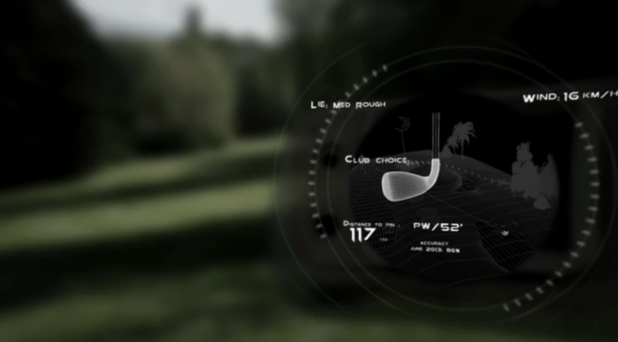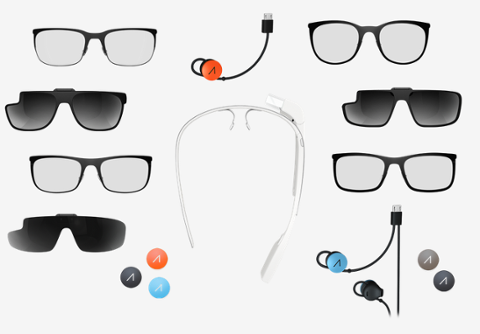[caption id="attachment_12760" align="aligncenter" width="618"]

The view through Recon Instruments' HUD.[/caption] For the past several months, Google has been methodically building hype for its upcoming
Google Glass technology. In addition to encouraging developers to tinker with the platform’s software, the search-engine giant has offered review units to a number of so-called “thought leaders” (as well as anyone willing to pay $1,500 for a pre-release model). All that hype aside, though, the question remains: will augmented-reality spectacles—and other types of wearable electronics—actually prove a hit with the public? Intel suspects so: the chip-builder has announced a “significant” investment in
Recon Instruments, which builds Heads-Up Displays (HUDs) for sports. That money will go to everything from development and marketing to sales. Like Google Glass, Recon’s headsets offer an open SDK for developing apps; the company also designs add-ons such as a wrist-mounted control module. Recon’s executives claim they’ve shipped more than 50,000 HUDs in the past few years. But polls offer a mixed picture of the public’s appetite for next-generation devices you strap to your head or wrist. Earlier this year, BiTE Interactive (in conjunction with YouGov)
conducted a survey that found only 10 percent of respondents would wear something like Google Glass regularly; almost half (45 percent) thought the device would be too socially awkward or irritating to wear outside.
Another survey, conducted a few months later by Opinion Research Corp. (and paid for by IT-staffing firm Modis) suggested that only 34 percent of respondents who made more than $100,000 a year would consider buying some form of wearable electronic—whether Google Glass, Apple’s much-rumored “iWatch,” or some other device. Percentages like those aren’t necessarily encouraging—and that’s before you start
asking people about privacy concerns—until you consider the gross numbers underlying it all: a small fraction of the population could still translate into millions of dollars in revenue for whatever company manages to come up with a hit device. The bigger question is whether a relatively limited market will support more than one or two players; and at least at this early stage, there are precious few indications that wearable electronics will blow up in the same way as cellphones or laptops. That could make things very good for Apple and Google, once their respective timepieces and spectacles hit the market, but very difficult for any competitors following in their wake. If Intel continues its investment, it may simply need to hope for the best. [caption id="attachment_12759" align="aligncenter" width="618"]

The view through Google Glass.[/caption]
Images: Recon Instruments/Google  The view through Recon Instruments' HUD.[/caption] For the past several months, Google has been methodically building hype for its upcoming Google Glass technology. In addition to encouraging developers to tinker with the platform’s software, the search-engine giant has offered review units to a number of so-called “thought leaders” (as well as anyone willing to pay $1,500 for a pre-release model). All that hype aside, though, the question remains: will augmented-reality spectacles—and other types of wearable electronics—actually prove a hit with the public? Intel suspects so: the chip-builder has announced a “significant” investment in Recon Instruments, which builds Heads-Up Displays (HUDs) for sports. That money will go to everything from development and marketing to sales. Like Google Glass, Recon’s headsets offer an open SDK for developing apps; the company also designs add-ons such as a wrist-mounted control module. Recon’s executives claim they’ve shipped more than 50,000 HUDs in the past few years. But polls offer a mixed picture of the public’s appetite for next-generation devices you strap to your head or wrist. Earlier this year, BiTE Interactive (in conjunction with YouGov) conducted a survey that found only 10 percent of respondents would wear something like Google Glass regularly; almost half (45 percent) thought the device would be too socially awkward or irritating to wear outside. Another survey, conducted a few months later by Opinion Research Corp. (and paid for by IT-staffing firm Modis) suggested that only 34 percent of respondents who made more than $100,000 a year would consider buying some form of wearable electronic—whether Google Glass, Apple’s much-rumored “iWatch,” or some other device. Percentages like those aren’t necessarily encouraging—and that’s before you start asking people about privacy concerns—until you consider the gross numbers underlying it all: a small fraction of the population could still translate into millions of dollars in revenue for whatever company manages to come up with a hit device. The bigger question is whether a relatively limited market will support more than one or two players; and at least at this early stage, there are precious few indications that wearable electronics will blow up in the same way as cellphones or laptops. That could make things very good for Apple and Google, once their respective timepieces and spectacles hit the market, but very difficult for any competitors following in their wake. If Intel continues its investment, it may simply need to hope for the best. [caption id="attachment_12759" align="aligncenter" width="618"]
The view through Recon Instruments' HUD.[/caption] For the past several months, Google has been methodically building hype for its upcoming Google Glass technology. In addition to encouraging developers to tinker with the platform’s software, the search-engine giant has offered review units to a number of so-called “thought leaders” (as well as anyone willing to pay $1,500 for a pre-release model). All that hype aside, though, the question remains: will augmented-reality spectacles—and other types of wearable electronics—actually prove a hit with the public? Intel suspects so: the chip-builder has announced a “significant” investment in Recon Instruments, which builds Heads-Up Displays (HUDs) for sports. That money will go to everything from development and marketing to sales. Like Google Glass, Recon’s headsets offer an open SDK for developing apps; the company also designs add-ons such as a wrist-mounted control module. Recon’s executives claim they’ve shipped more than 50,000 HUDs in the past few years. But polls offer a mixed picture of the public’s appetite for next-generation devices you strap to your head or wrist. Earlier this year, BiTE Interactive (in conjunction with YouGov) conducted a survey that found only 10 percent of respondents would wear something like Google Glass regularly; almost half (45 percent) thought the device would be too socially awkward or irritating to wear outside. Another survey, conducted a few months later by Opinion Research Corp. (and paid for by IT-staffing firm Modis) suggested that only 34 percent of respondents who made more than $100,000 a year would consider buying some form of wearable electronic—whether Google Glass, Apple’s much-rumored “iWatch,” or some other device. Percentages like those aren’t necessarily encouraging—and that’s before you start asking people about privacy concerns—until you consider the gross numbers underlying it all: a small fraction of the population could still translate into millions of dollars in revenue for whatever company manages to come up with a hit device. The bigger question is whether a relatively limited market will support more than one or two players; and at least at this early stage, there are precious few indications that wearable electronics will blow up in the same way as cellphones or laptops. That could make things very good for Apple and Google, once their respective timepieces and spectacles hit the market, but very difficult for any competitors following in their wake. If Intel continues its investment, it may simply need to hope for the best. [caption id="attachment_12759" align="aligncenter" width="618"]  The view through Google Glass.[/caption] Images: Recon Instruments/Google
The view through Google Glass.[/caption] Images: Recon Instruments/Google 